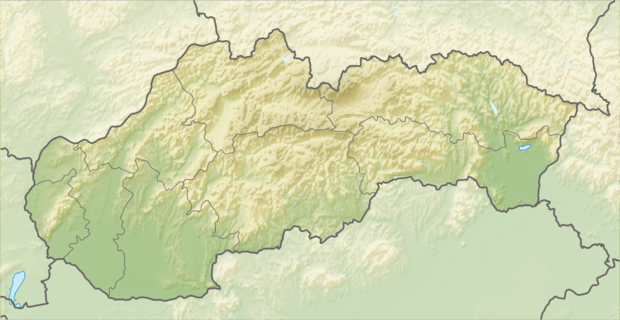Padáň
| Padáň Padány | |
|---|---|
| village | |
 Location of the village | |
| Coordinates: 47°55′55″N 17°40′00″E / 47.93194°N 17.66667°ECoordinates: 47°55′55″N 17°40′00″E / 47.93194°N 17.66667°E | |
| Country |
|
| Region | Trnava |
| District | Dunajská Streda |
| First written mention | 1254 |
| Government[1] | |
| • Mayor | Zoltán Szabó (Most-Híd) |
| Area | |
| • Total | 16.975 km2 (6.554 sq mi) |
| Elevation | 113 m (371 ft) |
| Population (2001)[2] | |
| • Total | 863 |
| • Estimate (2008) | 873 |
| • Density | 51/km2 (130/sq mi) |
| Ethnicity[2] | |
| • Hungarians | 94,44% |
| • Slovakians | 5,21% |
| Time zone | EET (UTC+1) |
| • Summer (DST) | EEST (UTC+2) |
| Postal Code | 930 09 |
| Area code(s) | +421 31 |
| Website |
www |
Padáň (Hungarian: Padány, Hungarian pronunciation:[ˈpɒdaːɲ]) is a village and municipality in the Dunajská Streda District in the Trnava Region of south-west Slovakia.
History
The village was first recorded in 1254 as Padan, an old Pecheneg settlement. On the territory of the village, there used to be Petény village as well, which was mentioned in 1298 as the appurtenance of Pressburg Castle. Until the end of World War I, it was part of Hungary and fell within the Dunaszerdahely district of Pozsony County. After the Austro-Hungarian army disintegrated in November 1918, Czechoslovakian troops occupied the area. After the Treaty of Trianon of 1920, the village became officially part of Czechoslovakia. In November 1938, the First Vienna Award granted the area to Hungary and it was held by Hungary until 1945. After Soviet occupation in 1945, Czechoslovakian administration returned and the village became officially part of Czechoslovakia in 1947.
Demography
In 1910, the village had 637, for the most part, Hungarian inhabitants. At the 2001 Census the recorded population of the village was 863 while an end-2008 estimate by the Statistical Office had the villages's population as 873. As of 2001, 94,44 per cent of its population was Hungarian while 5,21 per cent was Slovakian. 50% of the inhabitants profess Protestantism, while adherents of Roman Catholicism number 41,95% of the total population.[2]
References
External links
- NGO website (Hungarian)
- Local Reformed Church community (Hungarian)
- Local news selection at www.parameter.hu (Hungarian)